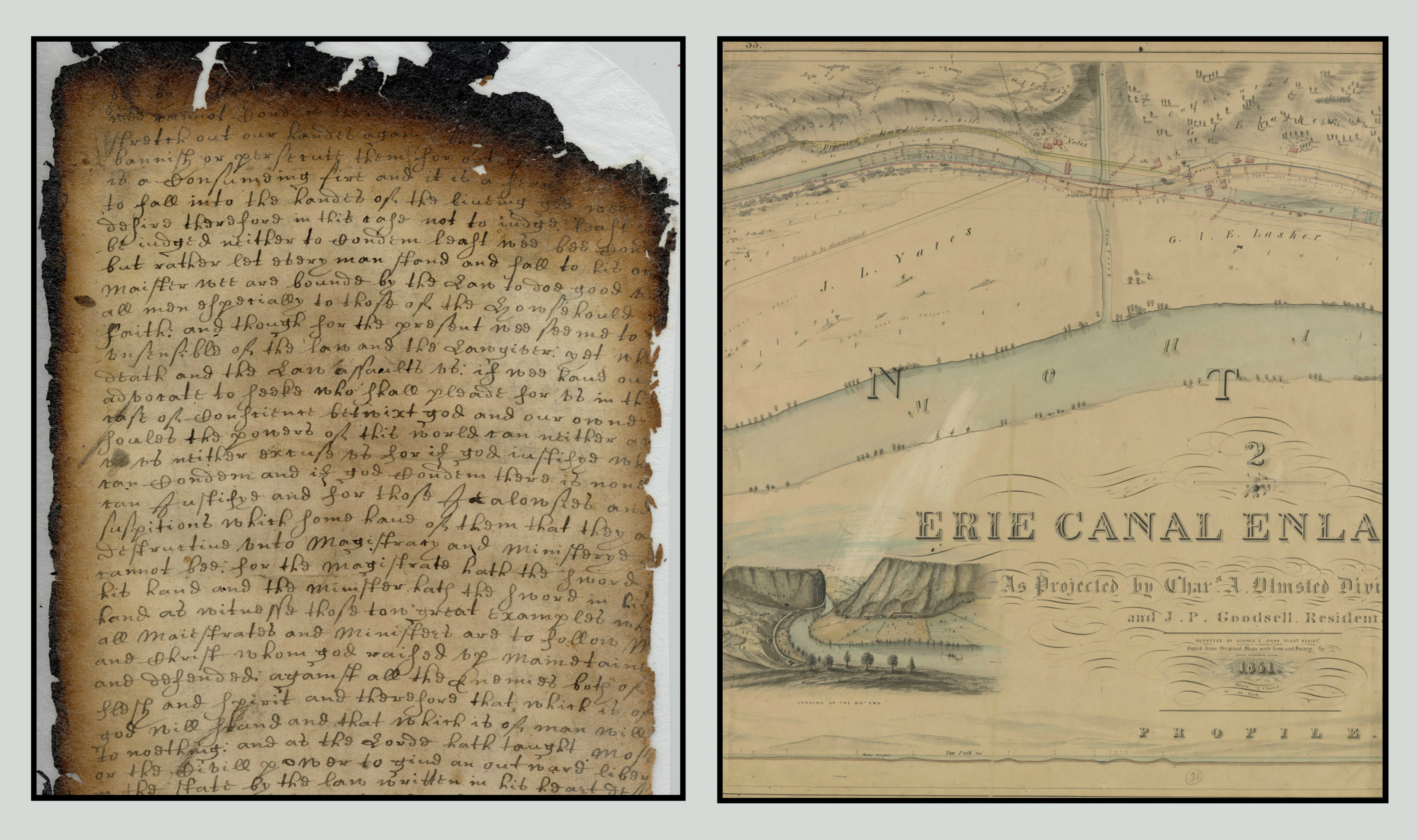Image: Detail of the Flushing Remonstrance; Erie Canal Document. Courtesy of the New York State Archives.
The Historical Society of the New York Courts, in partnership with the New York State Archives, extends an open invitation to attend a public event titled Documenting Our Past: Great Documents of New York Legal History on Thursday, November 30th at 6:30 PM at the New York City Bar Association. The program highlights major themes in New York law and jurisprudence, featuring attorneys, historians and archivists. For more information about the event and to register, click here.
Important themes in New York legal history are illustrated by original records preserved at the New York State Archives. Examples are the right to petition the government (the Flushing Remonstrance of 1657); a continuous, durable court system that provides judicial remedies, protects rights, and helps ensure social stability despite changes in political party or even political regime (New York trial court records, 1691-1847); and the New York’s development and management of transportation infrastructure, facilitated by or resulting in important innovations in property and contract law (records of construction and operation of the Erie Canal, starting 1817).
Right of Petition
The right to petition the government for relief was a right exercised in colonial New Netherland and New York, and is available to New Yorkers today. The right of petition is guaranteed by the New York State Constitution, Article I, Section 9.1. Though many petitions from the 17th, 18th, and 19th centuries were destroyed in the 1911 fire that consumed the State Library, many examples survive in the State Archives and will be illustrated at this event.
One of the oldest petitions in the New York State Archives is the 1657 “Flushing Remonstrance.” The mostly-English residents of Vlissingen, now Flushing, Borough of Queens, successfully petitioned the Director-General of the Dutch colony of New Netherland, Petrus Stuyvesant, to allow the Quakers of their community to worship in private, exempting them from the 1656 ordinance banning the public practice of religions other than the Dutch Reformed Church. Petitions to the Legislature in the mid-19th century sought voting rights for women. Modern New York governors frequently receive letters and petitions favoring or opposing legislative bills being considered for approval or veto.
Right of Due Process
From the 17th century to the present New York’s courts have protected rights of contract and property and helped ensure human liberty and safety. The modern New York Supreme Court provides judicial remedies and safeguards derived from English law, dating back to the Middle Ages. The royal governors of New York tightly controlled the court system, appointing all judges, but the court system, its procedure and protections, continued with little change during and after the American Revolution.
New York’s Bill of Rights declares that the English common law and acts of the colonial Legislature that were in effect in 1775 continue as the law of the state, as they have been amended by the Legislature in the 242 years since (Constitution Article I, Section 14). The Bill of Rights continues to guarantee the right to trial by jury (Constitution Article I, Section 2), and the right to the writ of habeas corpus (Constitution Article I, Section 4). These fundamental rights are part of New York’s inheritance from the common law and the British colonial era. Eighteenth-century writs of habeas corpus and jury panels from the New York State Archives will illustrate the continuity and durability of those fundamental rights.
Administration of New York’s courts during the era of the American Revolution demonstrates the continuity and stability of law, despite major challenges to the authority of the central government. New York’s royal government used the Supreme Court to suppress agrarian, anti-manorial rebellion in Dutchess County in the 1760s. New York Patriots employed the same court to prosecute and convict Loyalists during the Revolutionary War. Crucial elements of due process were observed and preserved, however one might perceive the elemental justice or injustice of the proceedings. Documents from the State Archives illustrate the efforts of both colonial and revolutionary courts to maintain order and punish offenders.
Property and Contract Rights
In the early 19th century New York State conceived, designed, constructed, and operated the Erie Canal, the largest public works project in the United States. Records of the Erie Canal in the State Archives document New York’s major new assertion of eminent domain powers for taking of lands and waters, with just compensation as is now guaranteed in New York’s Bill of Rights (Constitution Article I Section 7(a)). The Erie Canal was a catalyst for significant new developments in contract and commercial law. Canal records in the State Archives are also evidence of the most complex government administrative structure of the early 19th century, outside of federal government.
Understanding fundamental elements of New York’s Bill of Rights and judicial framework helps us appreciate the deep foundations of New York law and history. Join us on Thursday, November 30th to explore these themes, learn from legal experts and scholars and inspire further discussion, analysis and learning from historical documents of New York Colony and State.
For more about the program, speakers, and registration, click here.

